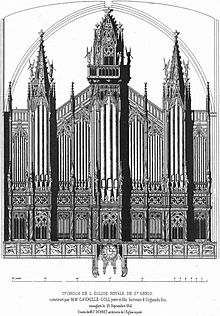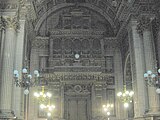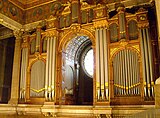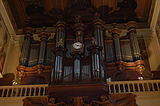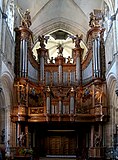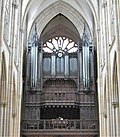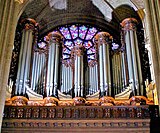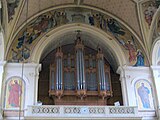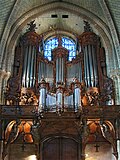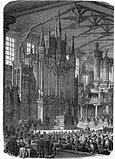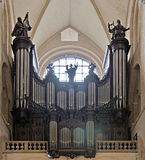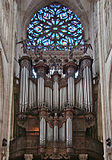Aristide Cavaillé-Coll

Aristide Cavaillé-Coll (born February 4, 1811 in Montpellier , † October 13, 1899 in Paris ) was a French organ builder , acoustician , scientist and inventor. He is considered the maître des maîtres ("master of the masters") of the French-Romantic organ building and is one of the most important organ builders of all time.
Cavaillé-Coll was born into a family of organ builders in the south of France and, thanks to his technical and mathematical talent, was able to take on a leading role in his father's company at an early age. On the recommendation of the composer Gioachino Rossini , he went to Paris at the age of 22 and only a few days later surprisingly won the competition to build the organ of the Basilica of Saint-Denis . For the first time he used the Barker lever , a pneumatic machine to facilitate the keystroke . Furthermore, he succeeded in absolute stabilization of the wind pressure by using parallel bellows . His middle creative period is determined by intensive acoustic and technical research, which among other things led to the perfection of the overblowing flute stops , the different wind pressures within a stop and the swell . He achieved world fame by building the organs of Saint-Sulpice and Notre-Dame de Paris .
The full, orchestral-symphonic grand chœur of the Cavaillé-Coll organs, characterized by tongue registers , inspired numerous composers and led to a heyday of French-romantic organ music, which culminated in the organ symphonies of Charles-Marie Widors and Louis Viernes . This tradition lives on in the French organ school to the present day.
Life
origin
Cavaillé-Coll's oldest known ancestors were fabric makers in Gaillac in southwest France. However, his great-grandfather's brother, the Dominican Joseph Cavaillé (around 1700–1767), learned the trade of organ building from Jean Esprit Isnard . Isnard built the organ of the Saint-Pierre-des-Cuisines church together with Cavaillé in Toulouse . Aristide Cavaillé-Coll's grandfather Jean-Pierre Cavaillé (1743–1809) was orphaned at an early age, learned organ building from his uncle Joseph and started his own business in Spain in 1765. In 1767 he married Françoise Coll in Barcelona .
On April 16, 1771 their son Dominique-Hyacinthe was born, who, according to Spanish custom , bore the double name Cavaillé-Coll . Dominique also learned the trade of organ builder, but left his family in 1788 due to disagreements with his stepmother and went to Spain, where he continued some of his father's interrupted work. He stayed in Spain until the beginning of the French Revolution . In 1791 he began a career as an officer in the French military, which he gave up in 1789 because of an injury and returned to Spain. Until his return to France in 1805 he built some organs there.
Childhood and Education (1811 to 1834)

Aristide Cavaillé-Coll was born on February 4, 1811 in Montpellier as the second son of Dominique Cavaillé-Coll and his wife Jeanne Autard; his older brother Vincent (born October 9, 1808, † 1886) was also an organ builder. The unrest in southern France due to the Bourbon restoration by Louis XVIII. In 1814 his father Dominique brought his family to Lérida in Spain. Aristide, who was only five years old, received insufficient schooling there and had spelling problems all his life. He also had no musical training: he did not learn to play an instrument, nor did he systematically acquire knowledge of music theory.
Fearing an epidemic in 1822, the Cavaillé-Coll family returned to France and lived in Gaillac from 1824 and in Toulouse from 1827. Aristide showed great craftsmanship early on. At the age of eleven he was already working on a workbench made for his size and also showed mathematical talent. When Dominique received a large number of orders from Spain in 1829, he sent the only 18-year-old Aristide to Lérida to finish an instrument that was left unfinished when he escaped. Aristide came up with numerous innovations. One of them was the parallelogram guide to prevent the parallel bellows from tilting. To his disappointment, he later learned that James Watt had invented this before him. Another innovation was the coupling with a foot lever (instead of a sliding coupling) and the operation of the swell mechanism with a foot lever (instead of using cables or hand levers as before).
After returning to Toulouse, together with his father and brother, he developed the Poïkilorgue, a harmonium-like instrument for chamber music use (the only two examples built are now in the Musée du Conservatoire ). When Gioachino Rossini visited Toulouse in 1832, the latter attracted his attention: Rossini conducted Giacomo Meyerbeer's opera Robert le diable in Toulouse , the first opera that required an organ in addition to the orchestra. Since the Toulouse Opera did not have an organ, a Poïkilorgue was made available without further ado : Rossini was overwhelmed by its sound and encouraged Aristide to go to Paris. In 1833, Cavaillé-Coll also invented a circular saw , for which he was awarded the bronze medal of the Société d'Encouragement on March 19, 1834 .
Construction of the organ of the Basilica of Saint-Denis and breakthrough in France (1834 to 1843)
Encouraged by Gioachino Rossini, the young Cavaillé-Coll took the opportunity to move to Paris on September 21, 1833 - equipped with numerous letters of recommendation and the like. a. for Gaspard de Prony , Sylvestre Lacroix , Charles Cagniard de la Tour and Luigi Cherubini as well as for the organ builders Henri Montan Berton , Sébastien Érard , Claude Callinet , Davrainville (* 1784) and Louis-Paul Dallery .
At the time of his arrival in Paris, organ building was largely in disrepair. Numerous organs were destroyed during the French Revolution. With François-Henri Clicquot the last great French organ builder 1791 was passed; around 1815 only Pierre-François Dallery and Jean Somer (who was later continued by Callinet ) were serious organ builders. The existing organs hardly corresponded to contemporary tastes: the orgue classique, i.e. H. The French baroque organ was characterized above all by the juxtaposition of characteristic sound groups: the mixture plenum (plein-jeu), the reed plenum (grand-jeu), solo reeds (such as voix humaine and cromorne ), as well as numerous aliquot registers (jeux de détail) and Cornet ; the pedal remained weak and was mostly only used for holding tones. The interaction of all registers with the coupling of all manuals in tutti was of less interest and was not easily possible due to the problems with the wind supply. Dynamic staggering was therefore only possible with gross disregard of the timbre.
Symptomatic of the dissatisfaction with the existing organ inventory is Felix Mendelssohn Bartholdy's description of the organ in Saint-Sulpice during his visit to Paris in 1832:
“I'm just from St. Sulpice, where the organist rode the organ for me: it sounds like a full-voice choir of old women's voices; but they claim that it will be the first organ in Europe if it is repaired, which is said to cost 30,000 francs. How the canto fermo sounds accompanied by a serpent, nobody who has not heard it will believe that and the big bells ring too! "
On arrival in Paris, Cavaillé-Coll was introduced to Henri Montan Berton , a member of the organ building committee of the Saint-Denis basilica . Pierre Érard (1796–1855), John Abbey (1785–1859), Louis Callinet (1786–1846) and Louis-Paul Dallery (1797–1875), the most important organ builders in France at the time , had already applied for the new organ . At Berton's suggestion, Cavaillé-Coll immediately went to the basilica to get to know the room; then, within three days, he sketched a design for a new organ in his hotel room. To everyone's surprise, the young, unknown Cavaillé-Coll - turned away at the door by Dallery only a few days earlier - was accepted on October 2, 1834. Soon after the news, his father also moved to Paris, where father and son opened a workshop in Rue Neuve-Saint-Georges N ° 14, near the Notre-Dame-de-Lorette church . Soon afterwards, Aristide was also commissioned to build the organ for this church. He delivered this instrument on October 22, 1838. Just three weeks earlier he had installed an organ in the Notre-Dame de Victoire church in Lorient .

According to the contract of 1833, the construction time for the organ in Saint-Denis was estimated at three years at a price of 80,000 francs for 81 stops on five manuals. Although the price was increased to 85,000 francs and the number of registers reduced to 71 under pressure from his father as early as 1834, the time schedule seemed hardly to be adhering to. Fortunately for him, the building of the organ was delayed through no fault of his own due to construction work in the interior of the church, but an organ of such hitherto unknown dimensions seemed to be afflicted with almost insoluble problems.
Unforeseen difficulties arose mainly from the fact that the organ would only have been playable with great effort when coupling all the manuals due to high wind pressures and the complicated mechanics - but this was precisely what the young Cavaillé-Coll had promised when the contract was signed. A key event for the building of the organs in Saint-Denis and for all modern organ building was the encounter with Charles Spackman Barker in 1837. Barker had recently invented a pneumatic machine that made it much easier to play. Barker had not found anyone interested in England, so he now tried to make his invention known in France. Cavaillé-Coll immediately recognized the potential of the invention and developed it further together with Barker. The organ of Saint-Denis received such a barker machine in the first manual , which made it possible to dispose this with an enormous 20 registers and to connect other manuals to it without any problems. The organ was inaugurated on September 21, 1841 and was a resounding success. From then on, Cavaillé-Coll was regarded as the most modern and leading organ builder in France.
Study trip through Europe (1844)
Buoyed by the success of the organ in Saint-Denis Cavaillé-Coll soon received many orders, such as the revision of the Clicquot - Organ of St-Roch 1842. 1844 traveled Cavaillé-Coll by Europe to current developments to study the organ building; Sigismund von Neukomm had laid out the route and wrote letters of recommendation. The passport dated September 9, 1844 states: “Height: 1.69 m; thirty-three years old; Brown hair; grey eyes". The itinerary was: Strasbourg , Rufach , Bern , Freiburg im Üechtland , Zurich , Winterthur , Stuttgart , Frankfurt am Main , Cologne , Haarlem , Rotterdam , Utrecht , London . In Strasbourg he inspected the clockwork of the minster and the organs of Andreas and Johann Andreas Silbermann and ruled:
"Nous avons ensuite entendu les orgues de Silbermann, père et fils. C'est bien comme jeux de fonds, mauvais comme jeux d'anches; en somme, ces orgues, sous le rapport de la mécanique et de la soufflerie, ont les mêmes qualités et les mêmes défauts que tous nos anciens instruments. »
“Then we heard the organs from Silbermann, father and son. As good as the basic voices are, the tongues are so bad; in short: as far as mechanics and wind supply are concerned, these organs have the same qualities and the same defects as all of our old instruments. "
He visited the organ of the cathedral of Friborg , built in 1834 by Aloys Mooser (IV / P / 68) and criticized its aural weakness. In Ludwigsburg he made the acquaintance of Eberhard Friedrich Walcker - "a man of merit" - to whom he had been a personal friend since then, and his nephew Carl Gottlob Weigle . A trip to Weingarten had to be omitted due to lack of time and money. This was followed on October 10 with a tour of the organ of the Paulskirche in Frankfurt (III / P + P / 74), which Walcker had built in 1833. It had a similar impetus for the development of the romantic organ in Germany as Saint-Denis in France. Here, too, he criticized the inadequate penetration of the reeds and solo voices, but praised the majestic basic character:
«C'est très beau, mais c'est toujours froid, comme un allemand. Il ya de la majesté dans les jeux de fond, de la maigreur dans les jeux d'anches, de la faiblesse dans les jeux de solo, un peu d'hésitation dans l'ensemble; les poumons manquent de force: de là le calme et la tiédeur des effets musicaux de l'instrument. […] 75 registres, trois claviers à mains, two claviers de pedales; tout cela en impose par le nombre. Mais, de même qu'un soldat français en vaut cinq des autres nations, un orgue de quinze registres à diverse pressions offre plus de puissance et plus de nuances, dans les effets sonores, que ce colossal instrument. Il ya néanmoins de bonnes choses, mais les poumons sont faibles; c'est un bel homme atteint de phtisie. »
“She is very beautiful, but always cold, like a German. The basic voices are majestic, the tongues lean, the solo registers weak, the overall sound somewhat timid; the lungs lack strength: hence the gentleness and mildness in the sound of the instrument […] 75 registers, three manual pianos, two pedal pianos; all of this impressed by the number. But just like a French soldier like five from other nations, an organ with 15 registers with different wind pressure levels offers more power and more nuances in sound than this colossal instrument. Nevertheless there are good things, but the lungs are weak: a beautiful person who has succumbed to consumption. "
He went on to Cologne and finally to Rotterdam, Utrecht and Haarlem in the Netherlands (visiting Christian Müller's organs ). There he made contact with Jonathan Bätz (1787–1849). The trip ended with brief visits to London and Birmingham ; he found the William Hills organ there from 1834 (Birmingham Town Hall) externally “abhorrent”, its 32 'prospect reminded him more of drainage pipes.
La Madeleine organ and wedding (1844 to 1855)
In 1846, the construction of the La Madeleine organ, with the extensive abandonment of aliquot registers and mixtures, marked another turning point in Cavaillé-Coll's work, to the great astonishment of the Parisian music world. So remarked Abbe H.-J. Ply :
“Indeed, when Mr Cavaillé-Coll was completing the La Madeleine organ, the music world was amazed to see that this 48-register instrument only had one aliquot, a third 3 ′. Some praised this innovation and Berlioz was certainly not among the last; most enlightened artists, however, criticized the builder for not building these registers; Used sparingly in a sensible registration, they give the organ its peculiar character, which distinguishes it from all other instruments. "
Contrary to the recommendations of the professional world (especially Marie-Pierre Hamels and Sigismund von Neukomms), Cavaillé-Coll had also dispensed with resounding tongues ; These were propagated by Georg Joseph Vogler , especially in Germany , and made it possible for the organist to use its own bellows to help the organist achieve smooth dynamics. The problems with mood, wind pressure and volume seemed too big to him. Instead, the desired romantic expressiveness should be achieved through a swell .
The time of a violent ideological conflict between Cavaillé-Coll and Félix Danjou about the future of organ building also dates from this phase . Danjou was very skeptical about the innovations in organ building promoted by Cavaillé-Coll. In 1838 he founded the Daublaine-Callinet organ building company together with Louis Callinet in Paris and Théodore Sauer in Lyon, whose most important work, the organ of Saint-Eustache , was destroyed by a fire caused by Charles Barker just six months after the organ was consecrated. Danjou propagated a reform against profane and operatic church music: Since the French Revolution, spiritual "private concerts" were in vogue for the metropolitan bourgeoisie and in the 1840s the organ left its traditional place in a liturgical function for the first time: organs were now also built in concert halls and private salons and conversely, organs in church buildings also played in purely profane concerts; Military marches and gallant operatic paraphrases were very popular. It made sense to use the organ and orchestra together on these occasions and let the organ imitate the instruments of the orchestra.
Cavaillé-Coll's organ in La Madeleine , architecturally a “pagan temple”, was the main target of a series of articles in Danjou's Revue de la musique religieuse, populaire et classique in 1847 ; He admitted that Cavaillé-Coll had a high level of craftsmanship and technical ability, but he only used this to imitate orchestral instruments and thereby rob the organ of its tonal characteristics. Orchestral instruments are made for sensual music that is out of place in the church; The same applies to the built swell works and overblowing registers. The organ in La Madeleine fell ill
“The noisy brilliance of the trumpets and the intrusive tone of the flutes. The service does not need to repeat the miracle that brought down the walls of Jericho. "
The favorite organist of Cavaillé-Colls (and the audience) in the 1840s was Louis Lefébure-Wély , known for his improvisational art and as an important collaborator for Cavaillé-Coll's ideal sound, he was involved in almost all organ consecrations. In a manner similar to how Cavaillé-Coll was attacked by Danjou and Stephen Morelot for his opera-like profaned organ playing, he was confronted with the German organist Adolf Hesse . Hesse had been known in Paris since the inauguration of the Saint-Eustache organ in 1844 (on this occasion he had also played in St-Denis on personal recommendation and accompanied by Frédéric Chopin ); Received only moderately enthusiastically by the audience, it nevertheless made an impression in professional circles with its flawless legato and pedal play and brought this into contact for the first time with the organ works of Johann Sebastian Bach . Cavaillé-Coll's enthusiasm for Lefébure-Wély only waned when he met the Belgian organist Jacques-Nicolas Lemmens - a pupil of Hesse - in 1850 . Lemmens was enthusiastic about the Cavaillé-Coll organs, which he got to know in Paris; For his part, Cavaillé-Coll saw Lemmens' amalgamation of Bach's counterpoint and romantic expressiveness as opening up a new world of organ music in an area that was completely alien to Lefébure-Wély. Not least because of Lemmens' influence, Cavaillé-Coll expanded the pedal range of his organs from the 1850s in order to make Bach's organ works playable on them.
In 1854 the company moved from the too small workshop in Rue Notre-Dame-de-Lorette (Rue Neuve-Saint-Georges had been renamed) to Rue de Vaugirard N ° 94-96. A new large hall with a high vault made it possible to assemble and demonstrate large instruments. Also in 1854, he married Adèle Blanc on February 3, with whom he later had six children (Cécile, Emmanuel, Joseph, Gabriel, Pierre and Isabelle). Pierre and Isabelle died early, Emmanuel became a decorative painter, Joseph fell as a marine at the age of 22, Gabriel also became an organ builder.
Construction of the organs of Saint-Sulpice and Notre-Dame-de-Paris (1856 to 1879)

After the death of his father in 1856, Aristide Cavaillé-Coll founded the limited partnership A. Cavaillé-Coll Fils & Cie . In the now beginning heyday of the company, around 20 instruments left Cavaillé-Coll's workshop on average. Decisive for the success of the workshop was also its attraction to talented employees. The number of employees ranged from 40 (in the crisis year 1848) to 75 employees (in 1878). Several generations of employees worked under Cavaillé-Coll and honored him as the patriarch of the workshop. Particularly noteworthy are the brothers Gabriel and Félix Reinburg, who were first-class voicers . The structure within the workshop was characterized by specialization in individual sub-areas; Everything was monitored by Cavaillé-Coll, who monitored the progress of work from his office and through regular tours.
In his office, Cavaillé-Coll was surrounded by various instruments, machines and models. He had a large specialist library. The equipment also included a device with which the first 32 harmonic partials could be reproduced in any sequence and combination through 32 organ pipes. Because of its enormous volume, it was also called machine infernale . Cavaillé-Coll had great skill in expressing the knowledge gained through these apparatuses in mathematical formulas; he can be counted among the founders of modern acoustic research. Among his acquaintances were the physicists Félix Savart , Jules Antoine Lissajous , Léon Foucault (to whom Cavaillé-Coll was helpful in calculating the exact speed of light ); Louis Pasteur was his neighbor for a time. Among the organ builders he counted Eberhard Friedrich Walcker , Friedrich Ladegast and Wilhelm Sauer among his friends, as well as the piano building family Érard and the clockmaker Jean André Lepaute .
Cavaillé-Coll was also in lively exchange with the musical greats of Parisian musical life. He regularly took part in private music evenings, for example with the composers Camille Saint-Saëns , Gioachino Rossini and the singer Pauline Viardot . His other friends also included Giacomo Meyerbeer , Louis Niedermeyer , François Benoist , Ambroise Thomas , Charles Valentin Alkan , Gabriel Fauré , Charles Gounod , Jules Massenet , Léo Delibes , François-Joseph Fétis , Hector Berlioz and Franz Liszt . Through the influential Sigismund von Neukomm, he was awarded the title of “Royal Organ Builder” in 1846. Cavaillé-Coll also had a significant influence on an entire generation of composers who later became world-famous as the French organ school : he sent Alexandre Guilmant and later Charles-Marie Widor to Lemmens to familiarize them with Bach's organ works and the German contrapuntal tradition. Widor later followed Louis Lefébure-Wély as organist in Saint-Sulpice. Towards the end of his life he met the young Louis Vierne and the eight-year-old Marcel Dupré , who asked him numerous questions about the organs in Notre-Dame and Saint-Sulpice while taking a walk on the banks of the Seine.

In the early days of the company, Cavaillé-Coll was technically far superior to its French competitors. It was not until the mid-1850s that Joseph Merklin became a technically serious competitor, at least in the French provinces; In terms of sound, however, he contented himself with copying Cavaillé-Coll. In the city of Paris, its primacy was undisputed. The international competition Cavaillé-Colls meanwhile built ever larger organs: In Liverpool in 1855 Henry Willis built a four-manual organ with 100 stops, in Ulm in 1857 Walcker built an instrument of the same size with a double pedal; Cavaillé-Coll himself admired Walcker's organ as "without doubt the greatest organ ever built". From 1857 onwards, Cavaillé-Coll planned to oppose foreign competition with an organ work of equal quality: the rebuilding of the organ in St-Sulpice (Paris) . The organ was built in 1781 by François-Henri Clicquot and should be renewed and expanded. The expansion to five manuals with 100 stops, completed in 1862, was groundbreaking and overwhelming for the domestic and foreign audiences. Cavaillé-Coll had achieved world fame.
From 1863 to 1868 Cavaillé-Coll built the organ of the Notre-Dame de Paris cathedral , with which he was able to repeat the success of Saint-Sulpice again. Economically, however, both projects were less successful; permanent financial problems forced him to take on two silent partners in the company. He could not get the contract to build the organ of St. Peter's Basilica , his design from 1875 with 8,316 pipes and 124 registers on five manuals did not go beyond a 1:10 scale model that Lemmens presented at a papal audience in 1878. At the same time, his professional success was overshadowed by personal grief: two of his children died in 1859, his mother in 1862 and his wife in 1868 giving birth to their last child.

In 1866 the workshop had to move again due to the town planning of the Prefect of Paris, Baron Haussmann , and from now on it was located in the Avenue du Maine near the Montparnasse train station . However, only a few instruments left the workshop during this period, shortly before the Franco-Prussian War .
Cavaillé-Colls organs in Great Britain (1866 to 1879)
In order to compensate for the lack of orders from France, Cavaillé-Coll moved to England. Up until now, his work had been admired there from afar, but the high cost of the order to a foreign company meant that no contract had been signed. The prelude was a new building for the Carmelite Priory in Kensington , which was inaugurated by Widor and Guilmant in 1866 . The then leading British organist, William Thomas Best , was impressed, as was the businessman John Hopwood; In 1870 he ordered an organ for his private use in Bracewell Castle , which was enlarged in 1875 and when he moved to Ketton Hall in Rutland in 1883. Even if it was too late to build the organ at the Royal Albert Hall ( Henry Willis had been commissioned), Hopwood provided Cavaillé-Coll with two more commissions in Sheffield and Blackburn .
The Town Hall (Sheffield) organ (IV / P / 64) from 1873 was his largest organ in Great Britain and another milestone in his work. It impressed with three swell mechanisms, the expansion of the manuals up to c 4 and a complete horizontal battery of solo reeds in 16 ', 8' and 4 'positions. In 1879 another larger concert hall organ followed for the Manchester Town Hall (IV / P / 48), which was expanded in 1893 and received the highest praise from James Kendrick Pyne , the organist of Manchester Cathedral :
"I have recently given a performance on an entirely new and costly organ belonging to an influential Corporation [...] and I can confidently say there is no comparison to be made between the two instruments, so superior is M. Cavaillé-Coll's."
"Recently I gave a performance on a completely new and expensive organ from an influential company [...] and I can confidently say that there is absolutely no comparison between the two instruments, that's how superior the instrument by M. Cavaillé-Coll is."
Of Cavaillé-Coll's eight British organs, only one remained in halfway original condition. Cavaillé-Coll's blaring tongue registers, the French gaming tables and game aids were too unfamiliar by English standards to be immune to anglicising changes. Symptomatic may be Reginald Whitworth's remark about the Sheffield organ in 1925:
“The great diapason tone, an the whole, is rather weak but very beautiful, and the 16ft flues have rather a tendency to predominate. If, however, the diapason tone of the swell, choir and solo is added, the general diapason tone is vastly improved. The chorus reeds are voiced very loudly and are rather brassy, no greater wind pressure than 6 in. Being employed, even for the solo organ. In England we are used to the smooth-toned reeds and heavy pressures of our great modern organ builders. [...] The solo trompettes en chamade in this instrument strike through the rest of this organ wonderfully well. "
“The tone of the Hauptwerk principal is by and large rather weak, but of great beauty, the 16-foot flutes tend to dominate the sound a little. But if you add the Swell Principals, Positive, and Solo Works, the principal sound is greatly improved. The reed choir is voiced very loudly and sounds rather metallic, with no wind pressure higher than 6 in. Required, even for the solo work. In England we are more used to the smooth sound of the tongues and high wind pressure from our larger modern organ builders. [...] The sound of the trompettes en chamade of the solo work floods the entire rest of the organ in a wonderful and beautiful way. "
Late work in Saint-Ouen and Saint-Sernin (1880 to 1899)
Cavaillé-Coll's late work was completed by two final modifications: the organ of the Saint-Ouen abbey church in Rouen and the organ of the Saint-Sernin basilica in Toulouse . In view of the huge rooms for which they were built, which are rather small, these conversions of previous organs are characterized by great sonic beauty and are in no way inferior to the organs of Notre-Dame and Saint-Sulpice with their enormous penetrating power.
Economically, the workshop was almost constantly facing bankruptcy in the last years of Cavaillé-Coll's life. His son Gabriel had learned the trade of organ building, but Cavaillé-Coll did not see him as his successor. Gabriel opened his own organ workshop, but soon failed and fled with the company's treasury to Spain, where he died in 1916. His father built his last large organ in 1898 for the Baron de L'Espée at Ilbarritz Castle near Biarritz with 70 stops on four manuals (it is now in the Basilique du Sacré-Cœur church ). The fact that former, well-trained employees of Cavaillé-Coll set up their own business in the province, such as Charles Mutin in Caen and Louis Debierre in Nantes , also had an impact on the order situation .
Cavaillé-Coll suffered from loss of sight and hearing. He was not ready to give up the high (but expensive) mechanical and artistic standards of his organs; He rejected innovations in organ building such as electrics and pneumatics, but continued to build with mechanical slide chests. Nevertheless, after his death, Albert Peschard and John William Hinton , the inventors of the early electro-pneumatic action , as well as Marcel Dupré tried to spread letters with him that Cavaillé-Coll had actually endorsed it and that it was only because of his old age that he no longer used it . That Cavaillé-Coll removed the electro-pneumatic action of the St-Augustin organ just a year before his death (Hinton called this an “act of vandalism”), Hinton ultimately explained with the “extreme senile inability” of an 87-year-old. More recent research, on the other hand, assumes that Cavaillé-Coll had been familiar with electricity in organ building since the 1850s through Henry John Gauntlett (1806–1876) and Paul-Gustave Froment , but rejected it out of artistic principles in favor of the Barker lever:
"The pneumatic lever has the advantage [compared to electricity] that it draws its energy precisely from the source that also generates the sound."
Thoughts about the use of electricity to operate the bellows are documented in letters; however, he rejected this because of the practical problems that the early days of electrics still brought with it.

His workshop was under Cavaillé-Coll's management until March 15, 1898. In order to avoid the economic decline, he now handed the company over to Charles Mutin (1861–1931), whom he had trained. Under Mutin's leadership, the company was soon making profits again, without the organs being inferior to those of Cavaillé-Coll in terms of quality. With the separation of church and state in France in 1905 , it became more and more difficult to finance large organs, and the quality of the organs also deteriorated due to Mutin's economic ambitions. Mutin gave up the workshop in 1924. The company existed until shortly after the Second World War.
After the handover of the company, Cavaillé-Coll and his daughter Cécile moved to Rue du Vieux-Colombier N ° 21 , near Saint-Sulpice. Aristide Cavaillé-Coll died very old on October 13, 1899 at the age of 88. His funeral mass took place in Saint-Sulpice with Widor as organist. He was buried on October 16 in the Montparnasse Cemetery in Paris.
Employee

Numerous young organ builders came to Aristide Cavaillé-Coll to learn and work with him. Some then became the most important in their area.
- Carl Friedrich Buchholz , around 1847/48, then co-owner of an important organ building workshop in Berlin
- Barnim Grüneberg , around 1848, then an important organ builder in Pomerania
- Wilhelm Sauer , around 1852, then an important organ builder in Brandenburg
- Friedrich Ludwig Theodor Friese around 1853/54, then an important organ builder in Mecklenburg
- Max Terletzki , 1860–1861, then an important organ builder in East Prussia
- Josef Angster , 1863–1866, then an important organ builder in Hungary
- Charles Mutin , 1875 – around 1881, bought the A. Cavaillé-Coll Fils & Cie company in 1898 .
- Samuel Marie Casavant , 1878, then major organ builder in Canada
- Salomon Van Bever , 1879–1880, then an important organ builder in Belgium
- Victor Gonzalez , 1894 – around 1898, then organ builder in Paris and the surrounding area
Other organ builders based their works in part on the model of Cavaillé-Coll, especially on the organ in St Sulpice, without any direct personal contacts having been proven so far, for example Friedrich Ladegast.
Between 40 (1848) and 75 (1878) employees worked in the workshops. Among the most important were
- August Neuburger , from Mecklenburg, since 1850, then workshop manager until around 1885
- Gabriel Reinburg, voicer
- Félix Reinburg, voicer
- Joseph Koenig, voicer
plant
Structural and sonic features
Cavaillé-Coll transformed the classical French organ , whose basic principles he retained, into an expressive type of instrument to which orchestral-symphonic organ music in France has corresponded since the mid-19th century. The standardized disposition of the Cavaillé-Coll organ still influences international organ building , especially for large concert instruments, to this day. The inventions and characteristics of the Cavaillé-Colls organs include:
Wind supply
- Stable wind supply : If there are irregularities in the wind supply, both the volume and pitch of the organ pipes vary. Cavaillé-Coll was the first to succeed in keeping the wind supply absolutely stable through the consistent use of parallel bellows as storage; Wedge bellows are used solely to generate wind, i. H. used to fill the magazine bellows.
- Different wind pressures: With the aim of matching the sound of organ registers to the instruments of the orchestra, he also adjusted the wind pressure closer to the pressure of the human lungs. Until then, the wind pressure for the entire organ was usually between 50 and 100 mm water column. Cavaillé-Coll found out through measurements that trumpeters can generate a wind pressure between 500 and 1000 mm water column. As a result, he increased the wind pressure for tongue registers to 85 to 120 mm water column. However, since other registers would overblown at high wind pressures , he used different wind pressures for different registers with the help of regulating bellows. In order to obtain an even sound within a register, he also increased the wind pressure within a register - especially for the high register of the trumpet register. This enables an intonation that emphasizes the upper part melody, especially the flute register, which can thus be accompanied by itself.
Action and console
- Slider drawer : Mechanical slider drawers are almost always made of oak; apartfrom an experiment in St-Vincent-de-Paul ,the cone drawer never gained his appreciation.
- Barker levers: From around 20 to 25 registers, Barker levers are built in the first manual to make it easier to touch and to enable pianistic playing. In large organs (St-Sulpice and Notre-Dame) the stop action is also facilitated by Barker levers, which reduces the length of the stops from 15–20 to 1–2 cm.
- Introductory step (appel): The wind chest is divided into jeux de fond (basic labial voices in the 16 ', 8' and 4 'range) and jeux de combinaison (higher labial register, mixtures and tongue register (anches) ). The jeux de combinaison can by kicking a wind check valve , the appel d'anches off and become connected.
- Gaming table: The gaming table is built as a play cabinet, where it is forced by a back positive. Otherwise it is built free-standing in front of the organ, the organist has his back to the organ. Typical of Cavaillé-Coll's conception of the organ is the occasional amphitheatrical, “orchestral” arrangement of the stops around the organist; However, there is regularly a terrace-like arrangement, with two steps belonging to a manual, the pedal is at the top. The keyboard is made of ebony and ivory. The swell step was built in the shape of a spoon until 1865 and can be locked in various positions, later it will be replaced by the balancing step.
- Extension of the manual and pedal range: The manual range is initially expanded to f 3 , later to g 3 , and occasionally up to c 4 . Cavaillé-Coll initially built the pedal according to the old French custom as a ravalement with a range of F 1 –f 0 (for example, in his first opus in Saint-Denis); later (from the 1850s) then from Cf 1 .
Pipework and disposition
- Pipework: Metal pipes are made from 80% tin, lead is hardly used. The metal is not hammered, solder seams are characterized by the utmost regularity. Brown painted Canadian fir wood is the material of the wooden pipes, the feet are made of polished oak. Principals (montres) are built with a fairly large scale. The prospect pipes get strongly raised labia. When existing organs are rebuilt, large parts of the old pipework (he often praised Clicquot's work in particular) are retained as far as they can be integrated into the sound concept.
- Overblowing registers ( audio sample ; MP3; 1.2 MB): Cavaillé-Coll disliked the fact that registers in the upper registers mostly sounded thin and shrill. He attributed this to the fact that a pipe that was 1/16 the length of the deepest pipe, for example, had only 1/4096 of its volume. In the case of orchestral instruments such as the horn , on the other hand, the lowest and highest notes are always produced by a body of the same length and volume, which increases the volume and beauty of the sound. This gave him the idea of using overblowing organ pipes; these were already known to Dom Bédos and Michael Praetorius , but had not yet been able to prevail. For this, he again used different wind pressures within a register: the fundamental tone sounds in the first octave , but the first harmonic from f 2 ′ . Cavaillé-Coll also succeeded through acoustic research in calculating the point of oscillation for the overblow hole precisely. Overblowing flutes in 8 ', 4' and 2 'registers characterize the sound of the labial registers of the swell, in the main work a flûte harmonique 8' is usually arranged as a solo register. For the organ in La Madeleine he went so far as to build a double overblowing flute. Overblowing registers were usually given the addition of harmonique, e.g. B. flûte harmonique .
- Mixtures : The mixtures of the classical French organ building were perceived by Cavaillé-Coll as high and shrill and could not be reconciled with the desired fundamental sound. In the case of new buildings, plein jeux were rarely planned (an important exception is the organ from St-Ouen de Rouen with two classical mixtures), in the restoration of classical organs, mixtures were mostly either heavily reworked or replaced by Flageolett , Tierce , Larigot and Cornet . In order to reinforce the treble tone of the trumpet choir, he built so-called progressive mixtures from the 1850s onwards , which - without repeating - had an increasing number of high choirs. This avoids the equalizing effect of the repeating mixtures in the course of the pitch, "The scale is restored to its right", as Georges Lhôtes put it. However, from the 1870s onwards, Cavaillé-Coll, probably under the influence of Alexandre Guilmant, returned to almost completely repetitive mixtures in the classical style, which together with the warm, fundamental sound of the jeux des fonds form the basis of the symphonic organ.
- Overall fundamental sound: The sound character is determined by the 8 'and 16' registers, with large organs a labial and a lingual 32 'register in the pedal form the sound basis. The overall sound remains transparent, however, as the individual registers already have a rich overtone spectrum.
- Tongue registers: are built in large numbers and with high wind pressure. Typically, the récit expressif has a wide set of reeds of 16 ', 8' and 4 ', whereby the 8' trumpet is built as a trompette harmonique with double the length of the bell. The positif is for solo purposes with a comparatively narrow trompette 8 ' scheduled, the main work regains three trumpets 16' + 8 '+ 4', sometimes - as in St-Sulpice - even two 8 'trumpets, one of which something close is scaled. The trumpets are also built as chamades based on the Spanish model , as in St-Ouen and St-Sernin in the prospectus; the chamade in St-Sulpice is really just a wide trumpet bent forward at right angles to high wind pressure.
- Beat register (jeux ondulants) ( Sample , MP3, 321 kB): The voix céleste was known in Italy since the 16th century, was in 1846 on the changes in the construction of the organ of La Madeleine and was the first beat register in France. Here it was still built in the (non-swellable) positif and later found its way into the swell box des récit . The voix céleste is the fasterbeat, the unda maris the slower beat and, in contrast to the voix céleste, is usually not swellable.
- Schwellwerk : The récit is mostly used as récit expressif, d. H. swellable, built; With this concept, which had been known in England since 1712, Cavaillé-Coll prevailed over the penetrating reeds in order to create the desired stepless dynamics on the organ. This récit expressif is always very richly arranged and forms, as it were, as a second major work, the sonic backbone of the symphonic organ. Cavaillé-Coll was thefirst toput voix humaine into the swell box. In connection with the appels , the organist was ableto createa practically stepless crescendo from the quietest pianissimo to the general tutti for the first time. In the so-called symphonic crescendo , all stops (except voix céleste and voix humaine ) are pulled and all manuals are coupled; the jeux de combinaison are closed by the appel without wind and the récit expressif , the so-called grand fond can be heard . Now the jeux de combinaison des récit is added , which, due to the closed swell, brings about practically no change in the sound. The organist now gradually opens the swell of the récit until the jeux de combinaison des positif is added and then gradually (if available) its swell also opens, whereupon the jeux de combinaison of the Grand-Orgue and finally the pedal around the Grand -Chœur to complete. As a final increase, super- and sub-octave couplings, octaves graves and octaves aiguës, can be added.
Architecture and prospectus
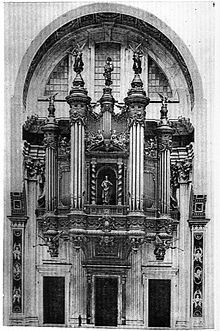
As far as possible, Cavaillé-Coll worked with the respective architects of the church buildings. Where this was not possible, he brought in the architect Alphonse Paul Joseph Marie Simil (1841-1916). He also designed the brochures for the company catalog in the clumsy style of the Second Empire . Existing back positives were mostly retained, but were not planned for new buildings. In order to avoid natural vibrations in the housing, it is sometimes made of fir.
Importance and Influence
Cavaillé-Coll's organ buildings are considered to be the cornerstones of the French organ school that still exists today. He had intuitively recognized that the organ would not be spared the fate of the harpsichord if it did not succeed in developing an independent, romantic type of organ. The question of causality - whether the new music provoked a new type of organ, or a new type of organ provoked new music - is answered almost unequivocally in favor of Cavaillé-Coll. After an organ test (most likely St-Denis) Rossini is said to have said: "Gentlemen, one would have to write music for such instruments." Widor expresses himself similarly clearly in the preface to the edition of his symphonies in 1887:
"C'est lui [Cavaillé-Coll] qui a imaginé the various pressions de soufflerie, the doubles layes des sommiers, the systèmes de pédales et de registres de combination, qui a pour la première fois appliqué les moteurs pneumatiques de Barker, crée la famille des jeux harmoniques, réformé et perfectionné la mécanique de telle façon que tout tuyau grave ou aigue, fort ou faible, obéit instantanément à l'appel du doigt, les touches devenant légères comme celles d'un piano, les résistances étant supprimées et la concentration des forces de l'instrument rendu pratique. De là résultent: la possibilité de détenir un orgue entier dans une prison sonore ouverte ou fermée à volonté, la liberté d'association des timbres, le moyen de les renforcer ou de les tempérer graduellement, l'indépendance des rythmes, la sécurité des attitudes , l'équilibre des contrastes, et enfin toute un éclosion de couleurs admirables, toute un riche palette aux tons les plus divers, flûtes harmoniques, gambes à frein, bassons, cors anglais, trompettes, voix célestes, jeux de fonds et jeux d ' Anches de qualité et de variété inconnues jusqu'alors.
Tel est l'orgue modern, essential symphonic. A l'instrument nouveau il faut une langue nouvelle, an autre idéal que celui de la polyphonie scolastique. Ce n'est plus le Bach de la fugue que nous invoquons, c'est le mélodiste pathétique, le maître expressif par excellence des Préludes, du Magnificat, de la Messe en Si, des Cantates et de la Passion suivant St. Matthieu. »
"It was he [Cavaillé-Coll] who had devised different wind pressures, split wind chests, pedal and register systems for combining, who was the first to use Barker's pneumatic machine, to create the family of overblown registers, to reform and perfect the mechanics, that every whistle, whether high or low, loud or soft, obeys the command of the fingers without delay, because the keys became as easy to play as the piano, because the touch resistance was eliminated and the concentration of all the forces of the instrument became practicable. From here it follows: the possibility of locking the organ in a sound prison that can be opened or closed at will, the freedom to merge timbres, the means to gradually strengthen or moderate them, rhythmic independence, security Sudden sound changes, balanced contrasts, and finally the development of the most wonderful sounds, a rich palette of the most varied of voices: overblowing flutes, viols, bassoons, English horns, trumpets, voces caelestes, basic and reed voices of previously unknown quality and variety.
So the modern organ is essentially symphonic. The new instrument calls for a new language, a different ideal than that of scholastic polyphony. It is no longer just the Bach of the Fugue that we refer to, it is the writer of the most beautiful melodies, the expressive master of the Preludes, the Magnificat, the Mass in B minor, the cantatas and the Passion according to Matthew. "
Shortly after his death, however, the orchestral-oriented romantic sound boom fell into disrepute as "decadent". Beginning in the 1920s, the period after the Second World War marked the heyday of the French neoclassical organ, which at times assumed the position of a quasi-official organ doctrine on the part of the advisory bodies of the French government. Similar to the organ movement in Germany, numerous organs were rebuilt with the desire to make music from all epochs playable on them. It is thanks to the dedication of the titular organists from St-Sulpice, Marcel Dupré and Daniel Roth , that Cavaillé-Coll's largest organ - in contrast to Notre-Dame - has been preserved almost completely in its original condition. A change of heart began in the 1980s and the preservation of the original condition or the dismantling is usually seen as worthwhile; the appointment to the titulaire of an original Cavaillé-Coll organ is considered a great honor.
Even before Cavaillé-Coll was generally valued again, Albert Schweitzer, as an important organ reformer, had emphatically advocated him:
“The best organs were built between around 1850 and 1880, when organ builders, who were artists, made use of the achievements of technology to realize the ideal of Silbermann and the other great organ builders of the 18th century to the highest possible degree. The most important of them is Aristide Cavaillé-Coll, the creator of the organs at St. Sulpice and Notre Dame in Paris. The one from St. Sulpice - it was completed in 1862 - which, apart from a few defects, I consider the most beautiful of the organs I know, still works as well today as it did on the first day and will be in 200 years if it continues to be well maintained to do it the same way. (...) Several times I met the aged Cavaillé-Coll - he died in 1899 - on the organ in St. Sulpice, where he used to appear every Sunday for church services. One of his favorite essences was: “ An organ sounds best when there is enough space between the pipes that you can walk around each one. ”“
List of works (selection)
Cavaillé-Coll has built 510 organs in over 50 years, most of them in France. Abroad, Cavaillé-Coll built organs a. a. in Spain , the Netherlands , England , Russia and Brazil ; In addition, there is an original organ by Aristide Cavaillé-Coll and several organs from the Mutin-Cavaillé-Coll workshop in Argentina .
In Germany there are only retrospectively purchased Cavaillé-Coll organs: the only one to date built by Cavaillé-Coll itself is located in Sankt Bernhard , Mainz (II / 15, built 1876/77, purchased in 1999). Organs from the successor workshop Mutin-Cavaillé-Coll are in the Osnabrück Cathedral ( choir organ ; II / 15, purchased in 1999), Cologne University of Music (II / 12, purchased in 2002), in the St. Nikolaikirche in Kiel (II / 18, purchased in 2003) , in the seminary church of the International Seminary in Zaitzkofen, Bavaria (II / 11, acquired in 1980) and in the Johanneskirche in Borken, North Rhine-Westphalia (II / 9, since 2010).
| year | opus | Huy bens |
place | church | image | ma nuale |
re- gister |
Remarks |
|---|---|---|---|---|---|---|---|---|
| 1841 | 10 | 481 | Saint-Denis | Saint-Denis Cathedral | IV / P | 69 |
first organ with Bark lever, reworked by Cavaillé-Coll in 1857 and expanded by Mutin in 1901, ravalement removed; 1983–1987 restored; largely preserved in its condition from 1841. Pierre Pincemaille has been titular organist since 1987 . |
|
| 1846 | 26th | 3 | Paris | La Madeleine (Paris) | IV / P | 48 |
Organ on which Alexandre-Charles Fessy , Louis Lefébure-Wély , Camille Saint-Saëns , Théodore Dubois , Gabriel Fauré , Henri Dallier , Édouard Mignan , Jeanne Demessieux , Odile Pierre and François-Henri Houbart worked. Audio sample Peter Ewers : Improvisation Dithyrambe |
|
| 1850 | Castelnau-d'Estrétefonds | St-Martin de Castelnau-d'Estrétefonds | ||||||
| 1852 | 52 | 78 | Paris | St-Vincent-de-Paul de Paris | III / P | 47 | ||
| 1852 | 56 | 491 | Saint-Germain-en-Laye | St-Germain de Saint-Germain-en-Laye | III / P | 40 | ||
| 1853 | 59 | 23 | Paris | Ste-Geneviève de Paris | II / P | 22nd | Abbey church became the Panthéon (Paris) in 1885 . Merklin moved the organ to the church of the Val-de-Grâce military hospital in 1891 ; Restored in 1993 by François Delangue and Bernard Hurvy. | |
| 1855 | 66/1 | 501 | Saint-Omer | Saint-Omer Cathedral | III / P | 50 | ||
| 1854- 1857 |
112/5 | 430 | Perpignan | Perpignan Cathedral | IV / P | 58 | ||
| 1857 | 127 | 353 | Luçon | Luçon Cathedral | III / P | 41 | ||
| 1846- 1858 |
14th | 64 | Paris | St-Roch | IV / P | 49 | ||
| 1859 | 88/22 | 30th | Paris | Ste-Clotilde | III / P | 46 |
Organ at the César Franck , Gabriel Pierné , Charles Tournemire , Joseph-Ermend Bonnal , Jean Langlais , Pierre Cogen and Jacques Taddei worked. |
|
| 1859 | 143/92 | 438 | Poligny | Collégiale St-Hippolyte | II / P | 26th | Intonation by Félix Reinburg, inauguration by Louis-James-Alfred Lefébure-Wély | |
| 1860 | 153/112 | 402 | Mulhouse | Église Saint-Étienne | II / P | 28 | ||
| 1861 | 163/127 | 404 | Nancy | Nancy Cathedral | IV / P | 65 | ||
| 1862 | 118/63 | 72 | Paris | St-Sulpice | V / P | 100 |
Conversion of an organ by François-Henri Clicquot from 1781, Cavaillé-Coll's largest organ with 100 registers, and even the largest organ in the world when the organ is consecrated; 1934 expanded to 102 registers; Restored by Renaud in 1991; almost completely original. Notable titular organists: Georg Schmitt , Louis-James-Alfred Lefébure-Wely , Charles-Marie Widor , Marcel Dupré , Jean-Jacques Grunenwald , Daniel Roth . |
|
| 1863 | 204/176 | 35 | Paris | St-Etienne-du-Mont | III / P | 39 | ||
| 1863- 1868 |
230/204 | 11 | Paris | Notre-Dame de Paris cathedral | V / P | 86 |
Audio sample (MP3; 481 kB) Léonce de Saint-Martin : Méditation improvisé |
|
| 1868 | 311/298 | 377 | Marseille | St-Joseph de Marseille | III / P | 43 | ||
| 1868 | 271/254 | 8th | Paris | La Trinité (Paris) | III / P | 46 |
Organ at which Charles-Alexis Chauvet , Alexandre Guilmant , Charles Quef , Olivier Messiaen , Naji Hakim worked. Audio sample: (MP3; 10.1 MB) Naji Hakim : improvisation on the hymn Pange lingua |
|
| 1869 | 327/314 | 297 | Epernay | Notre-Dame d'Épernay | III / P | 34 | ||
| 1873 | 374/363 | 587 | Sheffield | Albert Hall (Sheffield) | IV / P | 64 | ||
| 1874 | 367/356 | 178 | Angers | Angers Cathedral | III / P | 46 | ||
| 1875 | 330/317 | 580 | Ketton Hall | Mr. Hopwood | III / P | 45 | Hall organ from Bracewel from 1870 implemented and expanded by five registers | |
| 1875 | 428/425 | 579 | Blackburn | church | III / P | 32 | ||
| 1877 | 467 | 585 | Manchester | Town Hall (Manchester) | III / P | 32 | ||
| 1878 | 481 | 121 | Paris | Great hall of the Palais du Trocadéro | IV / P | 66 | ||
| 1880 | 522 | 592 | Brussels | Conservatoire de Musique (Brussels) | III / P | 44 | ||
| 1885 | 569 | 225 | Caen | St-Etienne de Caen | III / P | 50 | 1999 restored audio sample (MP3; 1.0 MB) Alain Bouvet: Demonstration des Tutti; More audio samples | |
| 1889 | 245/222 | 526 | Toulouse | St-Sernin | III / P | 54 |
Reconstruction of a Ducroquet organ (1843); Slightly rebuilt in 1932 and 1957; Comprehensively restored in 1996 and brought to the state of 1889. Audio sample (MP3; 3.4 MB) Louis Vierne : Messe Solennelle op. 16, Kyrie |
|
| 1890 | 630 | 467 | Rouen | St-Ouen de Rouen | IV / P | 64 |
Audio sample (MP3; 1.0 MB) Théodore Salomé : Canon en Ut majeur |
|
| 1897 | 688 | 299 | Epernay | St-Pierre-St-Paul d'Épernay | III / P | 38 | Audio sample (MP3; 213 kB) Odile Jutten: Improvisation | |
| 1898 | 642 | 186 | Armentières | St-Vaast d'Armentières | III / P | 50 | ||
| 1898 | 681 | 633 | Azcoitia | church | III / P | 40 | ||
| 1898 | 678 | 211 | Biarritz-Bidart | Ilbarritz Castle | IV / P | 70 |
Today in Paris, Sacré-Cœur de Montmartre . Audio sample (MP3; 321 kB) Charles Tournemire : L'Orgue Mystique op. 55–57, Prélude et Fresque |
honors and awards
- 1834: Médaille de Bronze from the Société d'Encouragement in Toulouse for the invention of a circular saw
- 1838: Médaille d'Argent of the exhibition of Arras
- 1844: Médaille d'Argent of the Société libre des Beaux-Arts for the organ of St-Denis
- 1844: Médaille d'Or at the Exposition Nationale de Paris
- 1849: Again Médaille d'Or at the Exposition Nationale de Paris
- 1849: Knight of the Legion of Honor
- 1854: Médaille d'Or of the Société d'Encouragement for the organ of St-Vincent-de-Paul
- 1855: Médaille d'Honneur at the World Exhibition in Paris
- 1864: Again Médaille d'Or of the Société d'Encouragement for the organ of St-Sulpice
- 1870: Premier Grand Prix at the World Exhibition in Rome
- 1870: Order of the New Year
- 1878: Officer of the Legion of Honor
- 1878: Grand Prix, Grande Médaille d'Or Unique at the World Exhibition in Paris
- 1888: Gold medal and Knight of the Order of Gregory for the project of an organ for St. Peter's Basilica
- 1889: Participation out of competition and participation in the jury of class XIII at the World Exhibition in Paris
- 1992: Namesake for the asteroid (5184) Cavaillé-Coll, discovered in 1990 by the Belgian astronomer Eric Walter Elst
Publications
- Études expérimentales sur les tuyaux d'orgue in reports of the Académie des Sciences (1849)
- De l'orgue et de son architecture in Revue générale de l'architecture des travaux publics (1856)
- Projet d'orgue monumental pour la basilique de St. Pierre de Rome (1875)
literature
Work editions
- Maison Aristide Cavaillé-Coll: Orgue de tous modèles . In: Alfred Reichling (Ed.): Documenta Organologica . Vol. II. Merseburger, Berlin 1977, ISBN 3-87537-145-3 (55th publications of the Society of Organ Friends. Facsimile of the first edition Paris 1899. Text part and epilogue in German translation.).
- Maison Aristide Cavaillé-Coll: Orgue de tous modèles - Facsimile of the sales prospectus on the occasion of the World Exhibition in Paris in 1889 . Ed .: Peter Ewers and Mirjam Krapoth. 3. Edition. Verlag Peter Ewers, Paderborn 2003, ISBN 3-928243-09-8 (With a foreword by Peter Ewers).
- Aristide Cavaillé-Coll: Complete theoretical works (Bibliotheca organologica) . Ed .: Gilbert Huybens. 2nd Edition. Frits Knuf, Buren 1981, ISBN 90-6027-192-0 (facsimile; Bibliotheca Organologica, Vol.XXXXI).
- Aristide Cavaillé-Coll: All theoretical work . Ed .: Christoph Glatter-Götz. Glatter-Götz, Schwarzach 1982.
Secondary literature - introductory literature
- James H. Cook: Cavaillé-Coll, Aristide (1811-1899) . In: Douglas E. Bush and Richard Kassel (eds.): The organ: An encyclopedia . Routledge, Taylor & Francis Group, New York / London 2006, ISBN 0-415-94174-1 , pp. 97-100 .
- Gregor Klein: Aristide Cavaillé-Coll . In: Supplement to L'Orgue Cavaillé-Coll, CD 10761 . Motette-Ursina, 2002, p. 16-19 .
- Hans Klotz : Cavaillé-Coll, Aristide . In: Music in the past and present . 1st edition. tape 2 . Bärenreiter, Kassel 1986, p. 920 ff .
Secondary literature - biographies
- Cécile Cavaillé-Coll and Emmanuel Cavaillé-Coll: Aristide Cavaille-Coll: Ses origines, sa vie, ses oeuvres . Fischbacher, Paris 2000, ISBN 2-7179-0000-4 (first edition: 1929, a biography written by Cavaillé-Coll's daughter Cécile).
- Cécile Cavaillé-Coll and Emmanuel Cavaillé-Coll: Aristide Cavaillé-Coll: his origins, his life, his work . Ed .: Christoph Glatter-Götz. Glatter-Götz, Schwarzach 1982 (translation of the biography of Cécile Cavaillé-Colls).
- Fenner Douglass: Cavaille-Coll and the musicians. A documented account of his first thirty years in organ building . 2 volumes. Sunbury Press, Raleigh 1980, ISBN 0-915548-09-7 .
- Fenner Douglass: Cavaille-Coll and the French Romantic Tradition . Yale University Press, 1999, ISBN 0-300-07114-0 (biography of Cavaillé-Coll until around 1850 based on the two-volume edition from 1980. Contains an appendix with numerous original documents translated into English).
Secondary literature - work lists and dispositions collections
- Jesse Eschbach: Aristide Cavaille-Coll Vol. I - Compendium of the available dispositions . Ed .: Peter Ewers. Peter Ewers Verlag, Paderborn 2004, ISBN 3-928243-05-5 (With an essay by Agnes Armstrong).
- Roland Galtier: Orgues de Cavaillé-Coll. List chronologique des travaux 1824–1898 . Fischbacher, Paris 1984, ISBN 2-7179-0006-3 .
- Gilbert Huybens: Cavaillé-Coll: List des travaux exécutés / catalog raisonné . Orgelbau-Fachverlag Rensch, Lauffen / Neckar 1985, ISBN 3-921848-12-1 (Complete catalog of works published by the International Society of Organbuilders (ISO). Text in French, English and German.).
Secondary literature - individual aspects
- Jesse Eschbach and Lawrence Archbold: Aristide Cavaillé-Coll: Master of Masters . In: Kerala J. Snyder (Ed.): The Organ as a Mirror of Its Time. North European Reflections, 1610-2000 . Oxford University Press, Oxford 2002, ISBN 0-19-514415-5 , pp. 230-241 .
- Michael Howard: Tribute to Aristide Cavaillé-Coll . St Michael's Abbey Press, Farnborough 1986, ISBN 0-907077-33-1 .
- Kurt Lueders: Reflections on the Esthetic Evolution of the Cavaillé-Coll Organ . In: Fenner Douglass, Owen Jander and Barbara Owen (Eds.): Charles Brenton Fisk: Organ Builder: Essays in His Honor . Westfield Center, Easthampton, Mass. 1986, ISBN 0-9616755-0-0 , pp. 136 .
- Christophe Mantoux: Cavaillé-Coll: visionary and traditionalist. On the aesthetic connection of the symphonic reform concept Aristide Cavaillé-Colls to the organ building tradition of the 18th century . In: Organ . tape 8 , 2005, p. 54-57 .
- Loïc Métrope: La Manufacture d'Orgues, avenue du Maine. Aux Amateurs de livres / Klincksieck, Paris 1988, ISBN 2-90275-700-2 .
- Claude Noisette de Crauzat: Cavaillé-Coll . Edition Flûte de Pan, Paris 1984.
- Claude Noisette de Crauzat: Aristide Cavaillé-Coll (1811-1899) . In: Acta Organologica . tape 10 , 1976, p. 177–212 (detailed essay on the dispositions, the pipework, the architecture, the wind supply, the console and the wind chests at Cavaillé-Coll with numerous technical details).
- Paul Peeters: Walcker and Cavaillé-Coll: A Franco-German Competition . In: Kerala J. Snyder (Ed.): The Organ as a Mirror of Its Time. North European Reflections, 1610-2000 . Oxford University Press, Oxford 2002, ISBN 0-19-514415-5 , pp. 242-259 .
- Henri de Rohan-Csermak: Aristide Cavaillé-Coll . In: L'esprit Curieux . No. 11 . Le Peregrinateur, 1999, ISBN 2-910352-22-6 .
- Carolyn Shuster-Fournier: Les orgues de salon d'Aristide Cavaillé-Coll . Zurfluh, Bourg-la-Reine 1997 (L'Orgue. Cahiers et mémoires n ° 57-58).
- Frank N. Speller: Aristide Cavaillé-Coll, Organ Builder . 1968 (DMA dissertation, University of Colorado, 1968).
- Gerald Woehl : The wind in the “symphonic organ” with Aristide Cavaillé-Coll . In: Acta Organologica . 1984, ISSN 0567-7874 , p. 331–333 (explanations on the use of wind pressure, especially stable wind and different wind pressures, at Cavaillé-Coll with discussion of contemporary organ builders about “stable” and “living” wind).
Magazines
Sound carrier
- Kurt Lueders, Naji Hakim , Daniel Roth a . a .: L'orgue Cavaillé-Coll - anniversary edition. Motette-Ursina Verlag, 1987/1. July 2002. 6 CD, DDD . Motet 10761. (sound documentation of 34 instruments).
Web links
- Literature by and about Aristide Cavaillé-Coll in the catalog of the German National Library
- Homepage of the Association Aristide Cavaillé-Coll (French)
- Homepage of the French Ministère de la Culture et de la Communication about Cavaillé-Coll
- Short biography and online edition of Cavaillé-Coll's writings (French)
- Radio report on NDR by Walter Liedtke
Individual evidence
- ↑ a b c d e f g h i j k Claude Noisette de Crauzat: Aristide Cavaillé-Coll (1811–1899) . In: Acta Organologica . tape 10 , 1976, p. 177-212 .
- ↑ The formulation was coined around 1875 by Alphonse Mailly , cf. Jesse Eschbach and Lawrence Archbold: Aristide Cavaillé-Coll: Master of Masters . In: Kerala J. Snyder (Ed.): The Organ as a Mirror of Its Time. North European Reflections, 1610-2000 . Oxford University Press, Oxford 2002, ISBN 0-19-514415-5 , pp. 230-241 .
- ↑ James H. Cook: Cavaillé-Coll, Aristide (1811-1899) . In: Douglas E. Bush, Richard Kassel (eds.): The organ: An encyclopedia . Routledge, Taylor & Francis Group, New York / London 2006, ISBN 978-0-415-94174-7 , pp. 97 .
- ↑ a b c d e Gregor Klein: Aristide Cavaillé-Coll . In: Supplement to L'Orgue Cavaillé-Coll, CD 10761 . Motette-Ursina, 2002, p. 25-26 .
- ↑ a b c d e Gregor Klein: Aristide Cavaillé-Coll . In: Supplement to L'Orgue Cavaillé-Coll, CD 10761 . Motette-Ursina, 2002, p. 16-19 .
- ↑ a b c d Jesse Eschbach and Lawrence Archbold: Aristide Cavaillé-Coll: Master of Masters . In: Kerala J. Snyder (Ed.): The Organ as a Mirror of Its Time. North European Reflections, 1610-2000 . Oxford University Press, Oxford 2002, ISBN 0-19-514415-5 , pp. 230-241 .
- ^ Fenner Douglass: Cavaille-Coll and the French Romantic Tradition . Yale University Press, New Haven / London 1999, pp. 9 f .
- ^ A b Fenner Douglass: Cavaille-Coll and the French Romantic Tradition . Yale University Press, New Haven / London 1999, pp. 1-8 .
- ↑ a b c d e f g Christophe Mantoux: Cavaillé-Coll: visionary and traditionalist. On the aesthetic connection of the symphonic reform concept Aristide Cavaillé-Colls to the organ building tradition of the 18th century . In: Organ . tape 8 , 2005, p. 54-57 .
- ^ Paul Mendelssohn-Bartholdy: Travel letters from Felix Mendelssohn Barthodly from the years 1830 to 1832 . Hermann Mendelssohn, Leipzig 1861, p. 315 .
- ↑ a b c d Gregor Klein: Aristide Cavaillé-Coll . In: Supplement to L'Orgue Cavaillé-Coll, CD 10761 . Motette-Ursina, 2002, p. 19-23 .
- ↑ http://orguesfrance.com/ParisNDLoretteGO.html , viewed April 15, 2020.
- ↑ http://orguesfrance.com/LorientNDBonneNouvelle.html , viewed April 15, 2020.
- ↑ a b c d Hans Steinhaus: German organs in the judgment of Aristide Cavaillé-Coll . In: Acta Organologica . tape 14 , 1980, pp. 215-224 .
- ^ A b Fenner Douglass: Cavaille-Coll and the French Romantic Tradition . Yale University Press, New Haven / London 1999, pp. 172 .
- ↑ Quoted and translated from Fenner Douglass: Cavaille-Coll and the French Romantic Tradition . Yale University Press, New Haven / London 1999, pp. 63 .
- ^ Fenner Douglass: Cavaille-Coll and the French Romantic Tradition . Yale University Press, New Haven / London 1999, pp. 53-62 .
- ↑ Quoted and translated from Fenner Douglass: Cavaille-Coll and the French Romantic Tradition . Yale University Press, New Haven / London 1999, pp. 53 .
- ^ A b Hermann Busch: The new instrument needs a new language. Aristide Cavaillé-Coll and French organ music . In: Music and Worship . Vol. 59, ISSN 1015-6798 , pp. 42-56 .
- ^ Fenner Douglass: Cavaille-Coll and the French Romantic Tradition . Yale University Press, New Haven / London 1999, pp. 71-82 .
- ^ Fenner Douglass: Cavaille-Coll and the French Romantic Tradition . Yale University Press, New Haven / London 1999, pp. 98 f .
- ↑ a b c d e f g h Gregor Klein: Aristide Cavaillé-Coll . In: Supplement to L'Orgue Cavaillé-Coll, CD 10761 . Motette-Ursina, 2002, p. 27-33 .
- ↑ a b c Gregor Klein: Aristide Cavaillé-Coll . In: Supplement to L'Orgue Cavaillé-Coll, CD 10761 . Motette-Ursina, 2002, p. 23-24 .
- ↑ a b c Gerard Brooks: Cavaillé-Coll 'British organs . In: Organist's Review . Vol. 92, No. 2 , May 2006, ISSN 0048-2161 , p. 2-13 .
- ↑ See Albert Peschard: Notice biographique sur A. Cavaillé-Coll et les orgues électriques . Impr. De Larousse, 1899.
- ↑ Quoted and translated from Fenner Douglass: Cavaille-Coll and the French Romantic Tradition . Yale University Press, New Haven / London 1999, pp. 146 .
- ^ Fenner Douglass: Cavaille-Coll and the French Romantic Tradition . Yale University Press, New Haven / London 1999, pp. 143-153 .
- ↑ For students and Kintakten to other organ builders see briefly Thomas Lipski: On the 200th birthday of Aristide Cavaillé-Coll . In: Ars Organi 59/1. 2011. pp. 22–31, here p. 24f. ( PDF )
- ^ A b Fenner Douglass: Cavaille-Coll and the French Romantic Tradition . Yale University Press, New Haven / London 1999, pp. 18-20 .
- ^ Pierre Pincemaille: Le grand orgue Cavaillé-Coll de la Basilique de Saint-Denis. CD booklet, Solstice Records Sigean 1994, p. 5. In Saint-Denis, the pedal was only expanded to C to f 1 through conversion by Charles Mutin in 1901 .
- ^ Fenner Douglass: Cavaille-Coll and the French Romantic Tradition . Yale University Press, New Haven / London 1999, pp. 159 .
- ↑ Albert Schweitzer: From my life and thinking . Fischer, Frankfurt am Main 1995, p. 70.
- ↑ See Gilbert Huybens: Cavaillé-Coll: List des travaux exécutés / catalog raisonné . Organ building specialist publisher Rensch, Lauffen / Neckar 1985, ISBN 3-921848-12-1 .
- ↑ a b c d e f g h i j k l m n Carolyn Shuster-Fournier: Les orgues de salons d'Aristide Cavaillé-Coll . Zurfluh, Bourg-la-Reine 1997, p. 137-140 (L'Orgue. Cahiers et mémoires n ° 57-58).
| personal data | |
|---|---|
| SURNAME | Cavaillé-Coll, Aristide |
| BRIEF DESCRIPTION | French organ builder of the Romantic era |
| DATE OF BIRTH | February 4, 1811 |
| PLACE OF BIRTH | Montpellier |
| DATE OF DEATH | October 13, 1899 |
| Place of death | Paris |


